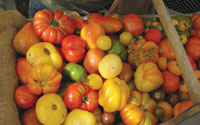
Fruit & Vegetable Report: Back to the Future
By Rosie Lombardi
Food Trends Sustainability consumer perception produce
 What’s old is new again. Resurrected out of forgotten nooks and crannies in gardens across Canada, many of the heirloom vegetables and fruits our forebears enjoyed are making a big comeback.
What’s old is new again. Resurrected out of forgotten nooks and crannies in gardens across Canada, many of the heirloom vegetables and fruits our forebears enjoyed are making a big comeback.
Several trends are coalescing to boost their popularity with consumers. Heirlooms are an offshoot of the organic and local produce movements, but have added connotations of genetic purity and links to local history. “Heirlooms aren’t adulterated by genetic engineering, and they’re closer to the land,” says Dana McCauley, a chef and corporate food consultant based in Maple, Ont. A series of food security scares and the recent release of the movie Food Inc. are driving people to seek healthier food choices as well. People are growing more concerned about the risks and energy costs associated with monocultured crops grown and shipped from huge agri-business operations in far-flung places.
The perception that heirlooms are tastier is also a major factor. “They’ve been selected for millennia for flavour, whereas modern genetics have selected species for uniformity, speed to market and durability in transport,” says Paul DeCampo, co-leader of Slow Food Canada, a non-profit eco-gastronomic organization.
People are also being exposed to heirlooms through Community Supported Agriculture (CSA) programs that deliver boxes of local produce to consumers, says Beth McMahon, executive director of the Atlantic Canadian Organic Regional Network (ACORN). “We’re also seeing growth in wildcrafting in agri-tourism – people will book a bed and breakfast so they can forage for fiddleheads and wild leeks.”
McCauley adds that heirloom varieties have become more commonplace in the past three years. “People are seeing them in fancy restaurants and specialty grocery stores, and they’re also growing them in their gardens.” In fact, sales of heirloom seeds are booming. “2009 has been a record-setting year for companies that sell them,” says Bob Wildfong, executive director of Seeds of Diversity, a Toronto-based non-profit organization dedicated to preserving the biodiversity of Canada’s food plants. “The fact that people are going to great lengths to grow heirlooms themselves is a heads-up to food producers,” notes McCauley.
Perception Meets Reality
The presumption that heirlooms are tastier is true in many instances, but it can’t be generalized across the board, says Wildfong. Flavour is subjective, and changes over time. Modern palates are accustomed to sweet corn, for example, which is a genetic mutant of maize that has been bred over the past 200 years, according to Elaine Roddy, vegetable specialist at the Ontario Ministry of Agriculture. “Corn was always eaten at the fresh stage in the past, but it didn’t taste great until it was bred for sugar content.”
Print this page